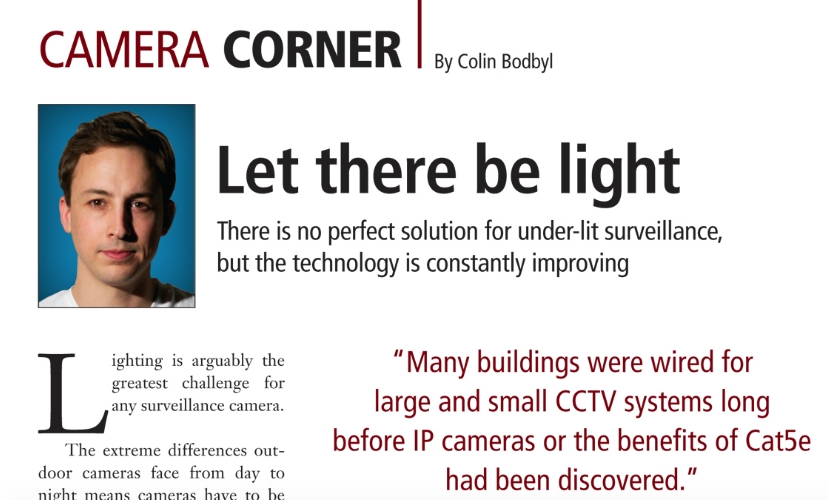
Features
Camera Corner
Opinion
Let there be light: No perfect solution for under-lit surveillance, but technology constantly improving
Lighting is arguably the greatest challenge for any surveillance camera.
March 15, 2017 By Colin Bodbyl

The extreme differences outdoor cameras face from day to night means cameras have to be able to adapt to lighting changes that vary from complete sun to total darkness. While camera resolution, frame rates and analytics have experienced drastic improvements over the last decade, low light technology has struggled to keep up.
IR (Infrared) lighting is the primary method for dealing with low-light conditions. IR is simple, inexpensive and easy to integrate into any camera. It is the oldest method for improving low light performance and has evolved over the years, but still faces many challenges. IR lights, like any light, have a finite lifespan. Some last longer than others but eventually they all fail. Since IR LEDs are not a health-monitored system component, they usually fail without any notice to the user. The first time users discover their IR lighting has burnt out is usually when they need to review recorded video and discover the recording is too dark.
Even if IR lights had an infinite lifespan, there are still several other trade-offs. IR requires the camera to be in monochrome or night mode, removing all colour from the scene and often making important details difficult to capture. IR also attracts insects, especially spiders who often find IR a warm place to make their home. The benefits of using IR, however, still outweigh the downsides. As long as integrators pay attention to the IR range of the camera and stay within it, IR will provide satisfactory results.
More recently, manufacturers have been releasing super low light cameras which combine low light image sensors with special processing techniques to provide colour images in low light applications. These cameras solve issues for a lot of scenarios where there is light but where that light is minimal, such as bars, nightclubs and partially lit outdoor areas.
Super low light cameras allow users to capture colour evidence in scenes that would otherwise require a monochrome camera. The benefits are obvious, but even these cameras will switch to monochrome and rely on IR illumination when no artificial white light is available. Thermal cameras are the ultimate low light technology for the right applications. While thermal cameras historically have been very expensive, prices are coming down with several manufacturers now selling thermal cameras for under a thousand dollars. These cameras do not rely on light at all as they measure temperature patterns instead. Since these cameras are not impacted by lighting changes they are extremely effective when running image analysis software like video analytics.
Part of the challenge for video analytics to work effectively is contrast, which usually varies depending on lighting conditions, but with thermal cameras the image contrast is constant. Of course the trade-offs when using thermal cameras are the complete lack of detail and low image quality due to their low resolution sensors and the fact that they are not able to capture colour.
No single camera can handle every lighting condition while simultaneously providing detailed colour images. IR technology still dominates the low light market but a lot of R&D effort is going into improving colour images in low light scenes so we become less reliant on IR. Thermal imaging is the ultimate technology for detection purposes and as costs come down these cameras will become more common for mid-market security applications. Low light performance may be one of the most challenging aspects of video surveillance with the slowest rate of advancements.
Unfortunately, with current technology there are always trade-offs anytime light is minimal. The key to success in any low light scenario is to understand what is important and select the correct technology based on what the customer needs to achieve.
Colin Bodbyl is the director of technology for UCIT Online (www.ucitonline.com).
Print this page